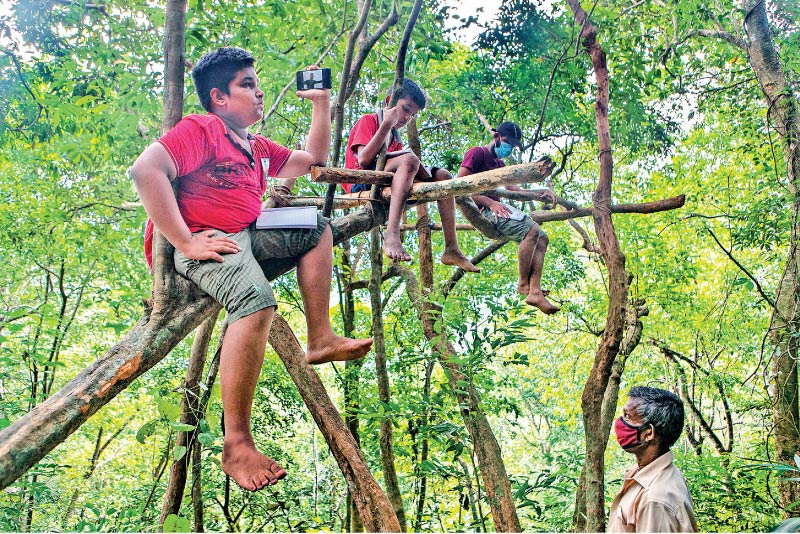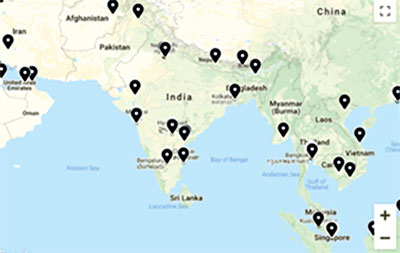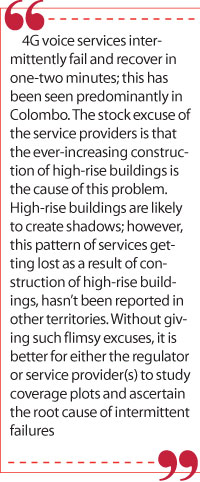Tuesday Apr 22, 2025
Tuesday Apr 22, 2025
Thursday, 16 September 2021 02:13 - - {{hitsCtrl.values.hits}}

Students in remote villages climb trees for phone signals to get access to e-classes – AP Photo
 Abstract
Abstract
Customer complaints are not unique to the Sri Lankan internet and telecommunication landscape but it is a common theme that needs to be addressed and provided an expeditious resolution to fix the defects. The regulatory and the ombudsman need to be two independent organisations in the policy setting in order to address grievances and complaints effectively. The inadequacy of system capacity, footprint and limited scalability to meet the growth, are key factors for the increase in the number of complaints and the inadequacy of legal framework in tackling them.
Preamble
Skimming through the internet for statistics on ranking countries based on internet speeds, both land and mobile, Sri Lanka stands in a substantive good position especially amongst Asia Pacific countries. But such data being compiled from that provided by the national authorities may be speculative and not reflect ‘critical factors’ vital for the end user to make informed service choices of acceptable quality: i.e. inclusive accessibility, affordability, accuracy and reliability performance and coverage. These rankings shouldn’t be taken for comfort, complacency and breathing space for the policymakers, without due consideration of ‘critical factors’.
The newspaper article on 11 July of the Sunday Times exposes the limitations of performance. The intention of this paper is not to limit the discussion of internet accessibility, a common resource, but to highlight some of the critical technical issues seen in Sri Lankan telecommunication and ICT sectors and the importance of the Integrated Information System (FIIS) and statutory framework.
Squalid state of broadband service
This doubt is affirmed by the agony lamented of the squalid state of broadband service reported on 11 July in the Sunday Times spotlighting the disregard of these ‘critical factors’ forcing students in remote villages deprived of schooling – by the COVID pandemic – to climb trees for phone signals in their quest to get access to e-classes. It’s a vivid display of not understanding the primary scope of ‘tele’ in telecommunication, the foundation that synergises the power of digitisation of information and economies of any networking, engendering the fourth industrial revolution that’s permeating globally Information Networked Services (INS), facilitating ease of, acquisition and processing data for exchange/dissemination of information of all types and their mix, availing Fully Integrated Information System (FIIS).
The importance of FIIS to Sri Lanka firmly endorsed in the Project ‘ICTA/AFC/C/IC03/58 eGovernment Strategy Dec 2013’, initiated by the then President, guaranteeing citizen-friendly, cost-effective and converged service delivery of information of all types and mix to all via economies of networked government implementable by 2020, shows the dedication of the then Sri Lankan leadership to partake in the global INS, that’s extremely vital to benefit optimally from synergies of networking economy and the emerging AI-driven telecommuting services and ‘fintech’ the cashless economy.
Now with the new Government whose priorities of developing infrastructure are at the forefront, the public expects the Ministry of Digitisation, an influential stakeholder, to take this initiative forward and make this a reality, immediately assigning the responsibilities to relevant workgroups without dumping in the backburner as in the past six years and delaying the benefit realisation without being rhetorical.
Although the current priorities have changed since the constitution of the report, the requirement and demand of internet access in the midst of the COVID pandemic has never been diminished but has grown ever since. Working-from-home, e-learning, home-schooling, e-marketing and e-selling, whatever connotations assigned, have exhorted the importance and the need for early action. Early implementation of FIIS with boost sector efficacy, harnessing of economies of networking, a vital prerequisite for digitisation of the economy starting the AI-driven e-court system of multidisciplinary composition.
Regrettably, the telecom regulator hasn’t played a lead role, over the years, in the FIIS implementation, let alone being equipped with FIIS – and is not equipped with even a basic info system that’s of paramount importance for sector regulation, disregardful that since the dismantling of the info system setup at the time of creation of the regulatory entity in 1991, the TRCSL information system has been diminished to crude set files, that too containing unvalidated data most not conforming to definitions and hence nullity capability to monitor and regulate.
It seems pertinent to mention the inability of the health sector to provide e-accurate COVID-19 data, said to be attributable to failure to provide a simple information system accessible from any location nationwide. Such a system is essential to acquire, store real time data of the relevant attributes for processing and retrieval of all necessary information of citizens tested for COVID, infections, vaccinations and deaths. Though it appears to be a rudimentary task that could be done by even an Advanced Level IT student, Data Science is an area of specialisation and professional competence to be developed and acquired by the regulator. As the sole portfolio owner of FIIS, there is no escape from the responsibility, neglect and obliviousness of the TRCSL team including the senior management.
The hallmark of a successful sector specific regulator is that it is much-respected within the sector being independent and by actions, if not revered, both by the service providers and service users. The simple question is that, is the TRCSL duly, faithfully and to the best of its ability performing its duty? It is also recently noted that regulators’ actions contravene the accepted norms set out in the governance framework in particular communication and handling complaints.
In complex situations where the resolution time exceeds the stipulated number of days, it is customary to acknowledge and provide a reference number for future enquiry in the event of any unusual delays of a permanent fix or a temporary workaround. In this information age it is very simple to build a web portal so that the complainer could track the progress of the fault handling process similar to the parcel tracking systems employed by logistic companies. The regulator should also enforce refunds for the period of non-availability of service.
Far more important and catastrophic is the absence of clarity of the following:
License terms and conditions, and criteria of issuance;
Sector specific public goods in particular, radio towers at strategic locations, way leave, Cabe landing sites management based on usage and cost data enabling licensees to operate without hindrance;
Sharing resources between service providers;
The national interests, and the interests of the customers of licensees are always secured in an environment of commercial operations by porting and analysing data from operator and their annual reports to the TRCSL FIIS;
Analysis of KPI of subscriber complaints received via phone, email post and others, by (a) voice calls (b) broadband usage (c) volume of SMS and (d) billing, etc.;
Assessment of quarterly data by operator per subscriber: per month (1) voice call usage minutes, (2) broadband usage in GB;
Establish basic web-based tools and guidance to educate the subscriber to make informed choices to enable satisfaction of user expectations at minimal cost. It would in turn help to boost market competitiveness; and
Establishment of clear regulatory framework and independent umpire, an ombudsman with requisite power, to resolve complaints and grievances of customers.
 Complaints of internet services
Complaints of internet services
4G voice services intermittently fail and recover in one-two minutes; this has been seen predominantly in Colombo. The stock excuse of the service providers is that the ever-increasing construction of high-rise buildings is the cause of this problem. High-rise buildings are likely to create shadows; however, this pattern of services getting lost as a result of construction of high-rise buildings, hasn’t been reported in other territories. Without giving such flimsy excuses, it is better for either the regulator or service provider(s) to study coverage plots and ascertain the root cause of intermittent failures.
If a person is mobile there could be failures as a result of, shadowing and also handing over the call from one cell to another due to multiple reasons; one could be all channels of the new cell are fully occupied at the time of handover. The issue is let alone nonconformance with technical requisites addressed in the documentation of the International, Telecommunication Union (ITU), the UN specialised body on telecommunication in which Sri Lanka has been a member even before independence.
Another poor-quality issue is that even with adequate signal levels the data connection becomes erratic. The tell-tale sign of this is the manifold reduction of one’s quota of data for the tariff paid for the file size downloaded due to repetitive transmission for error correction – retransmission of packets.
Furthermore, it is a fact that only Sri Lanka is without of a national IXP (Internet eXchange Point) since the forced closure of that was installed by CEO Lanakacom around 1997 and subsequent closure as a result of unconscionable conduct of SLT blocking traffic to and from their networks. The primary purpose of an IXP is to allow networks to interconnect directly, via the exchange, rather than going through one or more third-party networks.
The advantages of direct interconnection are cost, latency, and bandwidth. The given map shows the IXPs deployed in Asia and in South East Asia to throttle and exchange of internet traffic flow. The absence of IXP in Sri Lanka also leads to daylight robbery of data being metered and is certainly not mandating packages of unlimited data but correcting the error of poor quality in data transmission.
There are various complaints not only pertaining to voice calls over 3G or 4G but also communications over other applications viz WhatsApp, Viber, etc. where these services are purely carried by data packets. As per my view, the governance framework should address all areas that lead to loopholes where providers are likely to escape, and multiple interpretation of laid down provisions. The competition is good for the market economy, but access to telephones and internet is a Universal Service Obligation (USO) which is generally accepted.
 Suggestions:
Suggestions:
Mobile coverage problems of 3G and 4G can be addressed in various ways; for example, with Pico and Micro cells, sectorised antennas, in-building coverages deploying distributed antenna systems (DAS), consolidating assets so that service providers can share the infrastructure especially the transport network, antenna system without building towers in metropolitan areas hence destroying the aesthetic beauty.
Provision of internet services over existing copper or fibre optic are well-developed technologies and vastly deployed in many countries. The extension of fibre footprint other than in metropolitan areas needs to be explored considering the constraints of the terrain specially to reach the rural areas. Wi Fi hotspots is another way of providing equitable access to internet in the rural and suburban areas.
Although the competition among the providers is healthy, it needs to be regulated to address the access in the rural areas as well; demarcating areas and assigning each and every one to invest in non-profit areas of the rural sector. These principles are not new but adopted in many countries to increase the penetration thus fulfilling USO. I believe, TRCSL being the sole regulator will closely look into the public grievances in metropolitan, suburban and rural areas and consolidate some of the ideas written herein. Also, most importantly, to have a fair tariff system without resorting to asymmetric traffic where the service provider with larger footprint and market share can benefit from this, diminishing the competition.
Conclusion
I believe the public grievances and complaints are neither specific nor inheritance to Sri Lanka alone, this happening elsewhere even in the developed countries. However, they need to be managed effectively without flimsy and un-substantive excuses. The regulator and the ombudsman should be two independent organisations with very specific powers vested to them so that grievances/complaints are heard and penalties are imposed while redressing the situation. Hopefully, one day Sri Lankans will have reasonable access so that every person as per their needs, will benefit.
It is also important that specific task-oriented activities should be derived from the subject government strategy document and expedite the commencement of delivering the goals set out therein. As Sri Lanka is experiencing a debt crisis, learning the lessons from the past projects and ventures, I suggest that the present Government will explore and adopt a similar approach to what late former President J.R. Jayewardene took to accelerate the Mahaweli project and also how Sri Lanka built the national TV infrastructure in the 1980s.
Finally, the report of the South Asian Telecommunications Regulator’s Council (STARC) of Asia Pacific Telecommunity (APT) adopted at the 17th meeting, October 2016, shows that Sri Lanka has aptitude and appetite for internet taking a 20th out of 32 higher than India and Bangladesh in IDI (ICT Development Index). Where are we now? I am ending with a famous phrase in Latin, ‘Quo Vadis Sri Lanka’, where are we heading Sri Lanka?
Citations
[1] https://www.sundaytimes.lk/210711/business-times/climbing-trees-to-get-phone-signals-448806.html
[2] https://www.sundaytimes.lk/210711/news/oh-no-not-again-the-internet-is-stuck-449071.htm
[3] Detailed Study of the Lanka eGovernment Strategy Project ICTA/AFC/IC/IC03/58
[4] https://www.internetexchangemap.com/
[5] SATRC report on Identifying Ways to Lower International connectivity cost For the Provision of Broadband Services, October 2016
Discover Kapruka, the leading online shopping platform in Sri Lanka, where you can conveniently send Gifts and Flowers to your loved ones for any event including Valentine ’s Day. Explore a wide range of popular Shopping Categories on Kapruka, including Toys, Groceries, Electronics, Birthday Cakes, Fruits, Chocolates, Flower Bouquets, Clothing, Watches, Lingerie, Gift Sets and Jewellery. Also if you’re interested in selling with Kapruka, Partner Central by Kapruka is the best solution to start with. Moreover, through Kapruka Global Shop, you can also enjoy the convenience of purchasing products from renowned platforms like Amazon and eBay and have them delivered to Sri Lanka.
Discover Kapruka, the leading online shopping platform in Sri Lanka, where you can conveniently send Gifts and Flowers to your loved ones for any event including Valentine ’s Day. Explore a wide range of popular Shopping Categories on Kapruka, including Toys, Groceries, Electronics, Birthday Cakes, Fruits, Chocolates, Flower Bouquets, Clothing, Watches, Lingerie, Gift Sets and Jewellery. Also if you’re interested in selling with Kapruka, Partner Central by Kapruka is the best solution to start with. Moreover, through Kapruka Global Shop, you can also enjoy the convenience of purchasing products from renowned platforms like Amazon and eBay and have them delivered to Sri Lanka.